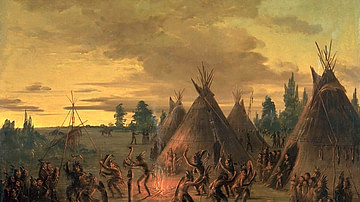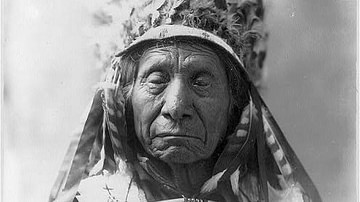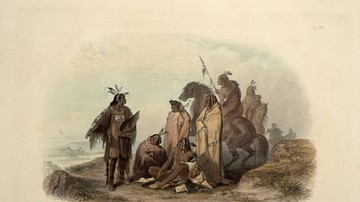Iktomi (also known as Unktomi) is a trickster figure of the lore of the Lakota Sioux nation similar to tricksters of other nations, such as Wihio of the Cheyenne, Nanabozho (Manabozho) of the Ojibwe, Coyote of the Navajo, or Glooscap of the Algonquin. As a trickster, he may cause harm or good but always brings transformation.
The concept of transformation is relayed in the form of a lesson learned either by himself or another character in the story that teaches the audience any one of several lessons including respect for nature, the importance of telling the truth, recognizing falsehood, being content with what one has, respect for oneself and one's community, and many others. These stories always encourage recognition of some important cultural value either by illustrating the concept in action or showing the consequences of violating it. Iktomi sometimes appears as a spider, sometimes as a man (a Sioux hunter, warrior, or sage), and is variously known as Ictinike, Ikto, Unktome, and most famously Unktomi by the different bands of the Sioux.
When the character was created or how old the stories are is unknown. The tales were passed down orally, generation to generation, until they were written down by European and Euro-American settlers, primarily in the 19th and early 20th centuries. Native American writers began to record their nation's legends, and those of others, at about this same time, including the Iktomi tales.
Iktomi the Trickster
Iktomi often interacts with Coyote, who sometimes serves as the trickster figure while Iktomi is the one taught the lesson (just as Ma'ii, the coyote figure of the Navajo, does in those stories). There are many variations on the Iktomi character, and when first introduced at the beginning of a story, the audience has no idea what part he is going to play. The story itself, therefore, mirrors the changeable nature of the character. In one piece, he will be the villain, in another the hero, in another a sage mediator, and in another a clown or buffoon.
In The Bound Children, for example, Iktomi is the sage who mediates a dispute between members of the community, while in White Plume, he is the villain who tries to steal the hero's identity and claim the beautiful maiden as his own. In the two tales that follow, Unktomi and the Arrowheads and Iktomi and the Coyote, the character is presented as a helper who is mistreated and as a buffoon who cannot tell the difference between a living animal and a dead one, respectively. Unktomi and the Arrowheads encourages respect for other living things, while the moral of Iktomi and the Coyote would be similar to the old adage, "don't count your chickens until they hatch."
Iktomi tales were, and still are, among the most popular Sioux legends as they are always entertaining while also providing an important cultural, religious, or common-sense moral. In this, they share ground with trickster tales of any culture, ancient or modern, around the world as trickster figures in general often drive the narrative of some of the most engaging texts, as with Loki in Norse mythology, Hermes in Greek mythology, or Reynard the Fox in European medieval folklore, among many others. Regarding such figures, scholar Larry J. Zimmerman writes:
Despite the different guises, the trickster exhibits similar characteristics wherever he is encountered. He can be a crafty joker and a bungler, who is usually undone by his own horseplay or trickery, ending up injured or even dead – only to rise again, seemingly none the wiser for his experience. At times irreverent and idiotic, his doings entertainingly highlight the importance of moral rules and boundaries.
(188)
The cultural importance of the trickster figure was recognized by the Swiss psychiatrist Carl Jung (l. 1875-1961), who included the concept in his archetypes as a psychological manifestation of one's juvenile and immature impulses, which, even so, should be acknowledged as, through its expression, one can recognize important personal truths. The trickster in Jung's work is an avatar, challenging how one defines oneself and offering the opportunity for change and growth. The Iktomi tales illustrate Jung's concept well in offering their audience the same possibility of seeing the world, and themselves, in a different light.
Text
The following tales are taken from Myths and Legends of the Sioux by Marie L. McLaughlin (Unktomi and the Arrowheads) and American Indian Stories and Old Indian Legends by Zitkala-Sa (Iktomi and the Coyote).
Unktomi and the Arrowheads
There were once upon a time two young men who were very great friends and were constantly together. One was a very thoughtful young man, the other very impulsive, who never stopped to think before he committed an act.
One day these two friends were walking along, telling each other of their experiences in love making. They ascended a high hill, and on reaching the top, heard a ticking noise as if small stones or pebbles were being struck together.
Looking around they discovered a large spider sitting in the midst of a great many flint arrowheads. The spider was busily engaged making the flint rocks into arrow heads. They looked at the spider, but he never moved, but continued hammering away on a piece of flint which he had nearly completed into another arrowhead.
"Let's hit him," said the thoughtless one.
"No," said the other, "he is not harming anyone; in fact, he is doing a great good, as he is making the flint arrowheads which we use to point our arrows."
"Oh, you are afraid," said the first young man. "He can't harm you. just watch me hit him." So saying, he picked up an arrowhead and throwing it at "Unktomi," hit him on the side. As Unktomi rolled over on his side, got up and stood looking at them, the young man laughed and said: "Well, let us be going, as your grandfather, "Unktomi," doesn't seem to like our company."
They started down the hill, when suddenly the one who had hit Unktomi took a severe fit of coughing. He coughed and coughed, and finally small particles of blood came from his mouth. The blood kept coming thicker and in great gushes. Finally, it came so thick and fast that the man could not get his breath and fell upon the ground dead.
The thoughtful young man, seeing that his friend was no more, hurried to the village and reported what had happened. The relatives and friends hurried to the hill, and sure enough, there lay the thoughtless young man still and cold in death. They held a council and sent for the chief of the Unktomi tribe. When he heard what had happened, he told the council that he could do nothing to his Unktomi, as it had only defended itself.
Said he: "My friends, seeing that your tribe was running short of arrowheads, I set a great many of my tribe to work making flint arrowheads for you. When my men are thus engaged, they do not wish to be disturbed, and your young man not only disturbed my man, but grossly insulted him by striking him with one of the arrowheads which he had worked so hard to make. My man could not sit and take this insult, so as the young man walked away the Unktomi shot him with a very tiny arrowhead. This produced a hemorrhage, which caused his death. So now, my friends, if you will fill and pass the peace pipe, we will part good friends and my tribe shall always furnish you with plenty of flint arrowheads." So saying, Unktomi Tanka finished his peace smoke and returned to his tribe.
Ever after that, when the Indians heard a ticking in the grass, they would go out of their way to get around the sound, saying, Unktomi is making arrowheads; we must not disturb him.
Thus it was that Unktomi Tanka (Big Spider) had the respect of this tribe, and was never after disturbed in his work of making arrowheads.
Iktomi and the Coyote
Far off upon a large level land, a summer sun was shining bright. Here and there over the rolling green were tall bunches of coarse gray weeds. Iktómi, in his fringed buckskins, walked alone across the prairie with a bare black head glossy in the sunlight. He walked through the grass without following any well-worn footpath.
From one large bunch of coarse weeds to another, he wound his way about the great plain. He lifted his foot lightly and placed it gently forward like a wildcat prowling noiselessly through the thick grass. He stopped a few steps away from a very large bunch of wild sage.
From shoulder to shoulder, he tilted his head. Still farther, he bent from side to side, first low over one hip and then over the other. Far forward, he stooped, stretching his long thin neck like a duck to see what lay under a fur coat beyond the bunch of coarse grass.
A sleek, gray-faced prairie wolf, his pointed black nose tucked in between his four feet drawn snugly together, his handsome bushy tail wound over his nose and feet. A Coyote – šuŋgmánitu asleep in the shadow of a bunch of grass, this is what Iktómi spied.
Carefully he raised one foot and cautiously reached out with his toes. Gently, he lifted the foot behind and placed it before the other. Thus, he came nearer to the round fur ball lying motionless under the sage grass.
Now Iktómi stood beside it, looking at the closed eyelids that did not quiver the least bit. Pressing his lips into straight lines and nodding his head slowly, he bent over the wolf. He held his ear close to the Coyote's nose, but not a breath of air stirred from it.
"Dead!" said he at last. "Dead, but not long since he ran over these plains! See! There in his paw is caught a fresh feather. He is nice fat meat!"
Taking hold of the paw with the bird feather fast on it, he exclaimed, "Why he is still warm! I'll carry him to my dwelling and have a roast for my evening meal. Ah-ha!" he laughed, as he seized the Coyote by its two fore paws and its two hind feet and swung him over head across his shoulders.
The wolf was large, and the teepee was far across the prairie. Iktómi trudged along with his burden, smacking his hungry lips together. He blinked his eyes hard to keep out the salty perspiration streaming down his face.
All the while, the Coyote on his back lay gazing into the sky with wide-open eyes. His long white teeth fairly gleamed as he smiled and smiled.
"To ride on one's own feet is tiresome, but to be carried like a warrior from a brave fight is great fun!" said the Coyote in his heart. He had never been borne on anyone's back before, and the new experience delighted him. He lay there lazily on Iktómi's shoulders, now and then blinking blue winks.
Did you never see a birdie blink a blue wink? This is how it first became a saying among the plains people. When a bird stands aloof watching your strange ways, a thin bluish white tissue slips quickly over his eyes and as quickly off again, so quick that you think it was only a mysterious blue wink. Sometimes when children grow drowsy, they blink blue winks, while others who are too proud to look with friendly eyes upon people blink in this cold bird-manner.
The Coyote was affected by both sleepiness and pride. His winks were almost as blue as the sky. In the midst of his new pleasure, the swaying motion ceased. Iktómi had reached his dwelling place. The Coyote felt drowsy no longer, for in the next instant, he was slipping out of Iktómi's hands. He was falling, falling through space, and then he struck the ground with such a bump he did not wish to breathe for a while. He wondered what Iktómi would do. Thus, he lay still where he fell.
Humming a dance song from his bundle of mystery songs, Iktómi hopped and darted about at an imaginary dance and feast. He gathered dry willow sticks and broke them in two against his knee. He built a large fire out of doors. The flames leaped up high in red and yellow streaks. Now Iktómi returned to the Coyote who had been looking on through his eyelashes.
Taking him again by his paws and hind feet, he swung him to and fro. Then as the wolf swung toward the red flames, Iktómi let him go. Once again, the Coyote fell through space. Hot air smote his nostrils. He saw red dancing fire, and now he struck a bed of cracking embers. With a quick turn, he leaped out of the flames. From his heels were scattered a shower of red coals upon Iktómi's bare arms and shoulders. Dumfounded, Iktómi thought he saw a spirit walk out of his fire. His jaws fell apart. He thrust a palm to his face, hard over his mouth! He could scarcely keep from shrieking.
Rolling over and over on the grass and rubbing the sides of his head against the ground, the Coyote soon put out the fire on his fur. Iktómi's eyes were almost ready to jump out of his head as he stood, cooling a burn on his brown arm with his breath.
Sitting on his haunches, on the opposite side of the fire from where Iktómi stood, the Coyote began to laugh at him.
"Another day, my friend, do not take too much for granted. Make sure the enemy is stone dead before you make a fire!" Then off he ran so swiftly that his long bushy tail hung out in a straight line with his back.






